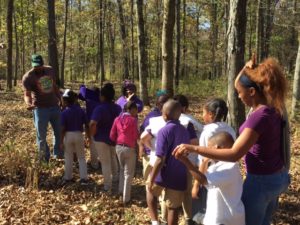Our Life Sciences programs offer a range of educational opportunities for different grade levels, featuring a series of educational activities that build on one another. Teachers can choose to implement these programs in-person or virtually. Teachers will also have the flexibility to request a complete series on a single topic or select activities from multiple topics to tailor the experience for their classroom.

Content Information
Tim Roberts
tim.roberts@utk.edu
Kelly Ravlija
krav@utk.edu
Khalaya Cooper
kcoope53@utk.edu
Sydney Grayson
sydlgray@utk.edu
Life Science Activities
3rd through 5th Grade

Discover the Forest
There are many amazing things in the forest for students to discover. Students are asked to reach in our Mystery Box and see if they can identify items by using their sense of touch. We discuss each item and how it relates to the forest. The students also learn about the parts of a tree and the important functions of each. Activities include a Every Tree for Itself and Competing for Life as a tree. This program is suitable for your 3rd through 5th grade students.
6th through 8th Grade
Creek Critters – Ecological Detectives
Students get to experience seining for Macroinvertebrates. The samples are taken back to one of Agricenter’s classrooms where we will examine and identify each and relate to how they relate to water quality. Students will also learn about the different ones in a stream with an activity.

Ecology of Organisms

As nature continues to evolve and change, this activity deals with topics professionals are concern with today.
- Do plants Adapt?
- Should forest be Clear Cut or Not?
- The Key to Trees.
- And even hare from professionals in the field.
Measuring the Forest
In this activity, students will learn why forests are important to monitor and how forest scientists (e.g. dendrologists) measure forests. Activity 1 introduces some information about US forests, Activity 2 teaches students to measure a single tree using DBH (diameter at Breast Height), and Activity 3 teaches students to calculate stand density. All activities can be done indoors, though going outside to measure real trees is a fun way to get kids outside!

9th through 12th Grade

Population Ecology
The students will be able to discuss current problems that affect us daily in nature.
- Chronic Wasting Disease (CWD). – What is CWD and How does it spread?
- Oh, Deer! Activity
- Population Models, Carrying Capacities, Growth Rates in a certain populations
- Talk with Experts
Biodiversity Balances
Another great opportunity for students to learn about current issues. The material is presented in a way for students to make their own conclusions and opinions.
- Native species vs. Invasive Species — how did they get here and how do we get rid of them.
- Plot investigation — students will identify native and non-native plants, make an observation hypothesis, then determine percentages to prove hypothesis, and make recommendations.
- Genetically Modified Organisms (GMOs) — what are GMOs, Pros and Cons, why they are used.
- Biodiversity Counts! — how we measure it and why it matters.
